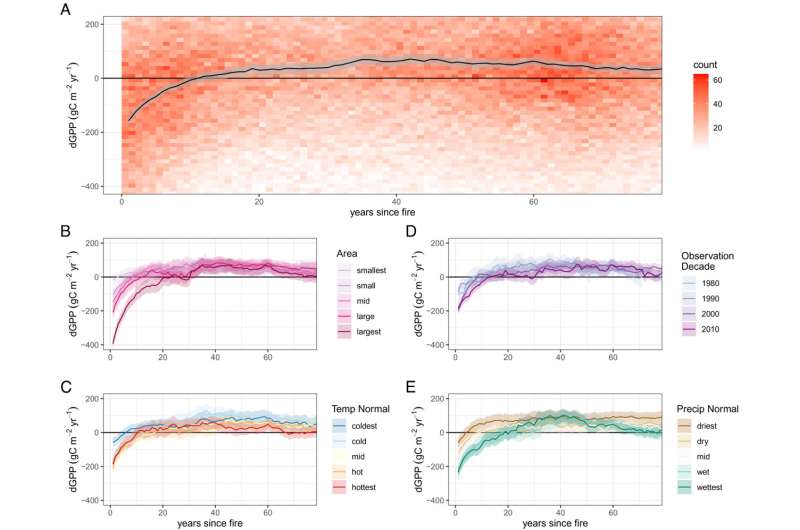April 5, 2023 report
This article has been reviewed according to Science X's editorial process and policies. Editors have highlighted the following attributes while ensuring the content's credibility:
fact-checked
peer-reviewed publication
trusted source
proofread
Increase in number of severe wildfires is slowing recovery of forests in California, reducing carbon uptake

A combined team of environmental scientists from Stanford University and the University of California, Irvine, has found that increases in the frequency of severe wildfires in California has been reducing the ability of forests to recover, resulting in a reduction in carbon uptake. In their study, reported in Proceedings of the National Academy of Sciences, the group used ground observations and satellite imagery to measure gross primary production (GPP) in forests in California over the last century.
Western parts of the United States, and California in particular, have seen more frequent wildfires in recent years, due at least in part to global warming. In this new effort, the research team sought to measure reductions in carbon uptake by forests due to increases in large fires.
Prior research has shown that after large fires that burn intensely, affected regions take more time to return to a forested state and to their prior amounts of carbon reduction uptake than do areas burned by smaller, less severe fires. To measure changes in GPP, which is the total amount of carbon uptake conducted by a given forest, the researchers studied data surrounding 5,000 fires in California forests over the past 100 years.
They found that GPP for such a forest, as expected, would decrease after a fire and remain at that low level for at least a year. They also found that it took on average 12 years for a forest to achieve pre-fire GPP levels. But they also found that for bigger and more intense fires, the drop was more severe and the time to recover was much longer—often spanning decades.
The research team found that due to increases in frequency, duration and intensity of wildfires in recent years, forests in California are taking much longer to recover. And that, they note, has led to an overall loss of carbon uptake for increasingly long periods of time. They suggest that better fire management practices geared toward allowing smaller fires to burn while reducing larger, more intense fires, could slow the reductions in carbon uptake due to fires.
More information: Kyle S. Hemes et al, The magnitude and pace of photosynthetic recovery after wildfire in California ecosystems, Proceedings of the National Academy of Sciences (2023). DOI: 10.1073/pnas.2201954120
Journal information: Proceedings of the National Academy of Sciences
© 2023 Science X Network





















